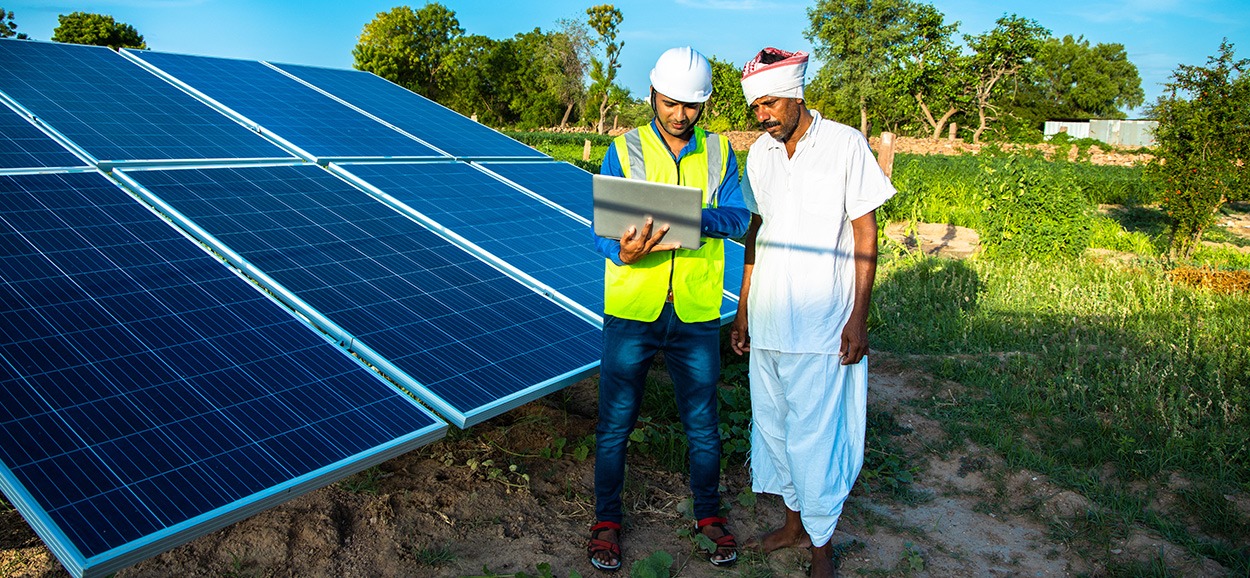Green solar energy has been gaining significant traction in India in recent years. The Indian government has been actively promoting renewable energy sources, including solar power, to address the country’s energy needs while reducing its carbon footprint. Here are some key points about green solar energy in India:
- Solar Power Potential: India has abundant solar energy resources due to its geographical location. The country receives around 300 days of clear sunlight per year, making it ideal for solar power generation.
- Government Initiatives: The Indian government has launched several initiatives and policies to promote solar energy adoption. The most notable one is the Jawaharlal Nehru National Solar Mission (JNNSM), which aims to achieve 100 GW of solar power capacity by 2022. This ambitious target has been further increased to 450 GW by 2030.
- Solar Parks and Ultra Mega Solar Projects: To facilitate large-scale solar power deployment, solar parks are being developed across the country. These parks provide infrastructure, land, and necessary clearances to attract solar power developers. Ultra Mega Solar Projects, such as the 2 GW Bhadla Solar Park in Rajasthan, have been established to boost solar power generation.
- Rooftop Solar Installations: The Indian government has also focused on promoting rooftop solar installations in residential, commercial, and industrial sectors. Various financial incentives, including subsidies and net metering policies, have been introduced to encourage individuals and businesses to adopt solar power systems.
- International Solar Alliance (ISA): India, along with France, launched the ISA in 2015, with the goal of accelerating solar energy deployment globally. The alliance aims to mobilize $1 trillion in investments by 2030 for solar power projects.
- Solar Energy Auctions: India has implemented a competitive bidding process for solar project allocation. The auctions have seen a significant decrease in solar power tariffs over the years, making solar energy more cost-competitive with conventional sources.
- Solar Manufacturing: India has also made efforts to enhance its domestic solar manufacturing capabilities. The government has introduced measures such as production-linked incentives (PLI) to boost the manufacturing of solar cells, modules, and other solar equipment within the country.
- Grid Integration and Storage: To ensure efficient utilization of solar power, the Indian government is focusing on grid integration and energy storage solutions. This includes the development of smart grids, battery storage systems, and hybrid solar-wind projects.
- Rural Electrification: Solar power has played a vital role in bringing electricity to remote and off-grid areas of India. The government’s decentralized solar power initiatives have provided access to electricity in villages where grid connectivity is challenging.
- International Cooperation: India has been actively collaborating with international organizations, countries, and industry stakeholders to exchange knowledge, technology, and best practices in solar energy. These collaborations help in fostering innovation and accelerating the growth of solar power in the country.
Overall, India has made significant strides in green solar energy adoption, aiming to transition towards a more sustainable and renewable energy future.
What is the percentage of green energy in India?
Renewable energy accounted for only 12.3% of total energy. India’s total renewable energy capacity, excluding large hydro and nuclear plants, reached 122 gigawatts in February 2023, the latest monthly report by the Central Electricity Authority (CEA) showed.
Which is the first green energy solar panel in India?
The first green energy solar panel in India was not limited to a single specific brand or model, as solar technology has been evolving over time. However, there were several early players in the Indian solar panel market that contributed to the growth of green energy. One of the prominent companies in the early days of solar power in India was Tata Power Solar (formerly Tata BP Solar). Tata Power Solar was established in 1989 and played a significant role in the initial development of solar panels in the country.
Over the years, several other Indian and international companies have entered the Indian solar panel market, offering various solar panel technologies and products. Some well-known Indian solar panel manufacturers include Adani Solar, Vikram Solar, Waaree Energies, and RenewSys. International manufacturers like Canadian Solar, Trina Solar, and JinkoSolar have also established a presence in the Indian market.
It’s worth noting that the solar panel market in India is dynamic and highly competitive, with new technologies and players continuously emerging. Therefore, the first green energy solar panel in India may not be attributed to a single brand or model, but rather to the collective efforts and advancements in the industry over time.
Which state has green solar energy?
Several states in India have embraced and implemented green solar energy initiatives. Here are a few states that are notable for their contributions to solar energy generation:
- Rajasthan: Rajasthan is one of the leading states in solar power generation in India. It has abundant solar resources and is home to several large-scale solar parks and projects, including the Bhadla Solar Park, which has a capacity of 2 GW.
- Gujarat: Gujarat has been a frontrunner in renewable energy adoption, particularly in solar power. The state has implemented various policies and incentives to attract solar investments and has a significant number of solar power installations, including the Charanka Solar Park.
- Karnataka: Karnataka is among the top solar energy-producing states in India. It has a favorable policy environment and has implemented innovative initiatives like solar rooftop programs and solar parks. The Pavagada Solar Park in Karnataka is one of the largest solar parks in the world.
- Tamil Nadu: Tamil Nadu has made substantial progress in solar power generation. It has implemented supportive policies and has a significant number of solar installations, including utility-scale solar projects and distributed solar systems.
- Andhra Pradesh: Andhra Pradesh has been actively promoting solar energy and has implemented various policies to attract solar investments. The state has several solar parks and is working towards achieving its renewable energy targets.
- Telangana: Telangana has emerged as a significant player in the solar energy sector. The state has implemented innovative policies and initiatives to promote solar power adoption, including the development of solar parks and rooftop solar programs.
It’s important to note that solar energy adoption is not limited to these states alone. Many other states in India, including Madhya Pradesh, Maharashtra, Uttar Pradesh, and Punjab, have also taken significant steps towards green solar energy generation, leveraging their solar potential and implementing favorable policies to encourage renewable energy growth.
What are the four types of green energy?
The four main types of green energy, also known as renewable energy sources, are:
- Solar Energy: Solar energy harnesses the power of sunlight to generate electricity or heat. It involves the use of solar panels (photovoltaic cells) to convert sunlight into electricity and solar thermal systems to capture heat for various applications.
- Wind Energy: Wind energy is generated by harnessing the power of the wind through wind turbines. Wind turbines convert the kinetic energy of the wind into mechanical energy, which is then used to generate electricity.
- Hydroelectric Power: Hydroelectric power is generated by harnessing the energy of flowing or falling water. It involves the use of dams or flowing water to drive turbines, which generate electricity. This includes both large-scale hydroelectric power plants and small-scale micro-hydro systems.
- Biomass Energy: Biomass energy is derived from organic materials such as plants, agricultural waste, and wood. It can be converted into electricity, heat, or biofuels through various processes like combustion, gasification, or fermentation. Biomass energy is considered renewable as the organic materials used for energy production can be replenished.
These four types of green energy play a crucial role in reducing reliance on fossil fuels, lowering greenhouse gas emissions, and promoting a sustainable and clean energy future. Other forms of renewable energy include geothermal energy, tidal energy, and wave energy, which are gaining attention and development in various parts of the world.
Why is it called green energy?
The term “green energy” is used to describe renewable energy sources that have minimal or no negative impact on the environment compared to traditional fossil fuels. Here are a few reasons why it is called “green energy”:
- Environmental Benefits: Green energy sources produce significantly lower levels of greenhouse gas emissions compared to fossil fuels. They do not contribute to air pollution or emit harmful pollutants, thereby reducing the overall carbon footprint and environmental impact.
- Renewable and Sustainable: Green energy sources are derived from natural resources that are renewable and sustainable. Sunlight, wind, water, and organic materials are continuously available and can be replenished naturally over time, making them a long-term and sustainable energy solution.
- Energy Independence: Green energy reduces reliance on finite fossil fuel resources that are often imported. By utilizing renewable energy sources, countries can increase their energy independence and reduce their vulnerability to price fluctuations and supply disruptions associated with fossil fuels.
- Climate Change Mitigation: Green energy plays a vital role in mitigating climate change. By reducing greenhouse gas emissions, it helps to combat global warming and contributes to the international efforts to limit temperature rise and address climate-related challenges.
- Resource Conservation: Green energy promotes the efficient use of resources. Unlike fossil fuels, which require extraction and finite reserves, renewable energy sources are naturally available and can be harnessed without depleting or damaging the environment.
The term “green energy” is often used to highlight the positive environmental attributes of renewable energy sources and to distinguish them from traditional fossil fuels, which have significant environmental and health impacts. By embracing green energy, societies can transition to a more sustainable and environmentally friendly energy system.





